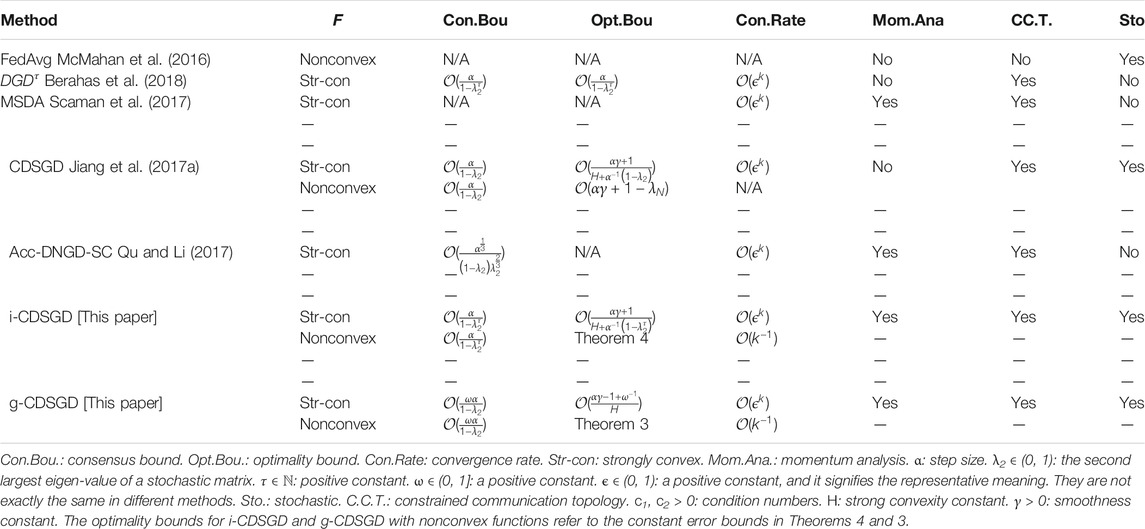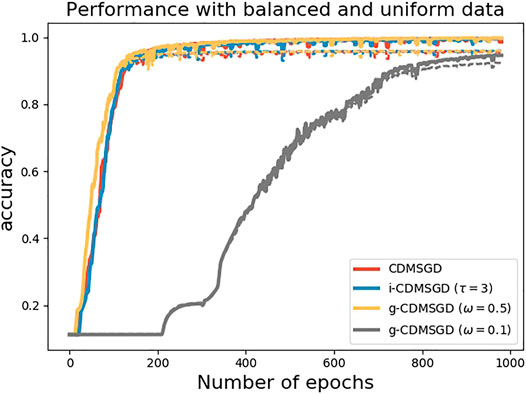- 1Self-aware Complex Systems Lab, Department of Mechaical Engineering, Iowa State University, Ames, IA, Unitd States
- 2Tandon School of Engineering, New York University, New York, NY, United States
In distributed machine learning, where agents collaboratively learn from diverse private data sets, there is a fundamental tension between consensus and optimality. In this paper, we build on recent algorithmic progresses in distributed deep learning to explore various consensus-optimality trade-offs over a fixed communication topology. First, we propose the incremental consensus-based distributed stochastic gradient descent (i-CDSGD) algorithm, which involves multiple consensus steps (where each agent communicates information with its neighbors) within each SGD iteration. Second, we propose the generalized consensus-based distributed SGD (g-CDSGD) algorithm that enables us to navigate the full spectrum from complete consensus (all agents agree) to complete disagreement (each agent converges to individual model parameters). We analytically establish convergence of the proposed algorithms for strongly convex and nonconvex objective functions; we also analyze the momentum variants of the algorithms for the strongly convex case. We support our algorithms via numerical experiments, and demonstrate significant improvements over existing methods for collaborative deep learning.
1 Introduction
1.1 Motivation
Scaling up deep learning algorithms in a distributed setting (Recht et al., 2011; LeCun et al., 2015; Jin et al., 2016) is becoming increasingly critical, impacting several applications such as learning in robotic networks (Lenz et al., 2015; Fang et al., 2019), the Internet of Things (IoT) (Gubbi et al., 2013; Lane et al., 2015; Hu et al., 2020), mobile device networks (Lane and Georgiev, 2015; Kang et al., 2020), and sensor networks (Ge et al., 2019; He et al., 2020). For instance, with the development of wireless communication and distributed computing technologies, intelligent sensor network has been emerging as a kind of large-scale distributed network systems, which request more advanced sensor fusion techniques that enable data privacy preservation (Jiang et al., 2017a; He et al., 2019), dynamic optimization (Yang et al., 2016), and intelligent learning (Tan, 2020). This paper aims at developing novel algorithms to facilitate collaborative deep learning in distributed settings such as distributed sensor networks (Lesser et al., 2012). Several distributed deep learning approaches have been proposed to address issues such as model parallelism (Dean et al., 2012), data parallelism (Dean et al., 2012; Jiang et al., 2017a), and the role of communication and computation (Li et al., 2014; Das et al., 2016).
We focus on the constrained communication topology setting where the data is distributed (so that each agent has its own estimate of the deep model) and where information exchange among the learning agents are constrained along the edges of a given communication graph (Jiang et al., 2017a; Lian et al., 2017). In this context, two key aspects arise: consensus and optimality. We refer the reader to Figure 1 for an illustration involving three agents. With sufficient information exchange, the learned model parameters corresponding to each agent,
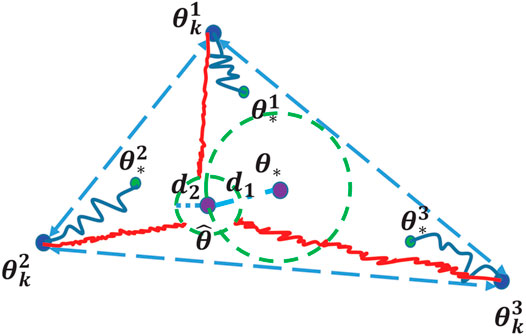
FIGURE 1. A closer look at the optimization updates in distributed deep learning: Blue dots represent the current states (i.e., learned model parameters) of the agents; green dots represent the individual local optima (
1.2 Our Contributions
In this paper, we propose, analyze, and empirically evaluate two new algorithmic frameworks for distributed deep learning that enable us to explore fundamental trade-offs between consensus and optimality. The first approach is called incremental consensus-based distributed stochastic gradient descent (i-CDSGD), which is a stochastic extension of the descent-style algorithm proposed in (Berahas et al., 2018). This involves running multiple consensus steps where each agent exchanges information with its neighbors within each SGD iteration. The second approach is called generalized consensus-based distributed SGD (g-CDSGD), based on the concept of generalized gossip (Jiang et al., 2017b). This involves a tuning parameter that explicitly controls the trade-off between consensus and optimality. Specifically, we:
•(Algorithmic) propose the i-CDSGD and g-CDSGD algorithms (along with their momentum variants).
•(Theoretical) prove the convergence of g-CDSGD (Theorems 1 and 3) and i-CDSGD (Theorems 2 and 4) for strongly convex and non-convex objective functions;
•(Theoretical) prove the convergence of the momentum variants of g-CDSGD (Theorem 5) and i-CDSGD (Theorem 6) for strongly convex objective functions;
•(Practical) empirically demonstrate that i-CDMSGD (the momentum variant of i-CDSGD) can achieve similar (global) accuracy as the state-of-the-art with lower fluctuation across epochs as well as better consensus;
•(Practical) empirically demonstrate that g-CDMSGD (the momentum variant of g-CDSGD) can achieve similar (global) accuracy as the state-of-the-art with lower fluctuation, smaller generalization error and better consensus.
We use both balanced and unbalanced datasets (i.e., equal or unequal distributions of training samples among the agents) for the numerical experiments with benchmark deep learning data sets. Please see Table 1 for a detailed comparison with existing algorithms.
1.3 Related Work
A large literature has emerged that studies distributed deep learning in both centralized and decentralized settings (Dean et al., 2012; Zhang et al., 2015; Blot et al., 2016; Jin et al., 2016; McMahan et al., 2016; Xu et al., 2017; Zhang et al., 2017; Zheng et al., 2017; Esfandiari et al., 2021), and we only attempt to summarize the most recent work (Wangni et al., 2017). proposed a gradient sparsification approach for communication-efficient distributed learning, while (Wen et al., 2017) proposed the concept of ternary gradients to reduce communication costs (Scaman et al., 2017). proposed a multi-step dual accelerated method using a gossip protocol to provide an optimal decentralized optimization algorithm for smooth and strongly convex loss functions. Decentralized parallel stochastic gradient descent (Lian et al., 2017) has also been proposed. In (Duchi et al., 2012), the authors developed a distributed averaging method for convex (possibly nonsmooth) objective functions; additionally (Mokhtari and Ribeiro, 2016), proposed a decentralized double stochastic averaging gradient algorithm. However, non-convex functions were not taken into account in either of the above works. Dual approaches (Uribe et al., 2020; Dvinskikh et al., 2019) were also proposed to address the convergence issues in the distributed optimization over networks while extra parameters need to be updated for obtaining the optimal solutions, which in return could increase the difficulty of solving the problem and the computational complexity. Again, convex problems were the main focus that might not enable the proposed schemes to generalize well for non-convex problems. Another category of approaches, the primal-dual gradient algorithms developed in (Hong et al., 2018; Dvinskikh and Gasnikov, 2019) were not evaluated by real-world datasets and were only originally specific for homogeneous networks where data was assumed independently identically distributed (i.i.d.).
Perhaps most closely related to this paper is the work of (Berahas et al., 2018), who presented a distributed optimization method (called DGDτ) to enable consensus when the cost of communication is cheap. However, the authors only considered convex optimization problems, and only study deterministic gradient updates. Also (Qu and Li, 2017), proposed a class of (deterministic) accelerated distributed Nesterov gradient descent methods to achieve linear convergence rate, for the special case of strongly convex objective functions. In (Tsianos and Rabbat, 2012), both deterministic and stochastic distributed were discussed while the algorithm had no acceleration techniques. To our knowledge, none of these previous works have explicitly studied the trade-off between consensus and optimality. It should also be noted that the proposed approaches guarantee the convergence to the first-order stationary points for non-convex analysis and the avoidance of local maxima and saddle points is out of scope.
Outline: Section 2 presents the problem and several mathematical preliminaries. In Section 3, we present our two algorithmic frameworks, along with their analysis in Section 4. For validating the proposed schemes, several experimental results based on benchmark datasets are presented in Section 5. Concluding remarks are presented in Section 6.
2 Problem Formulation
We consider the standard unconstrained empirical risk minimization (ERM) problem typically used in machine learning problems (such as deep learning):
where
In this work, we primarily consider the spectrum between consensus and optimality and investigate thoroughly what effect such trade-offs have on the decentralized learning paradigm. Specifically, we analyze the theoretical properties of the proposed algorithms and show the empirical findings over benchmark datasets. However, in realistic scenarios, the graph may be subject to changes, such as the addition of new agents, and robust decentralized learning algorithms need to be developed for tackling such an issue, which is out of the scope and will definitely be one of our future research directions beyond this work.
Let
Note that in this context, θj for all j = 1, 2, … , N is the local copy of θ, which means the model architecture for each agent is typically the same. In another line of works where agents own different models, personalized federated/decentralized learning (Fallah et al., 2020) or meta-learning approaches (Fallah et al., 2021) have been developed correspondingly. Equivalently, the concatenated form of the above equation is as follows:
where
We now introduce several key definitions and assumptions that characterize the above problem.
Definition 1. A function
Definition 2. A function c is said to be coercive if it satisfies: c(x) → ∞ when ‖x‖ → ∞.
Assumption 1. The objective functions
Assumption 2. The interaction matrix Π is normalized to be doubly stochastic; the second largest eigenvalue of Π is strictly less than 1, i.e., λ2(Π)<1, where λ 2(Π) is the second largest eigenvalue of Π. If
We will solve Eq. 2 in a distributed and stochastic manner.
For solving stochastic optimization problems, variants of the well-known stochastic gradient descent (SGD) have been commonly employed. For the formulation in Eq. 2, one of the state-of-the-art algorithms is a method called consensus distributed SGD, or CDSGD, recently proposed in (Jiang et al., 2017a). This method estimates θ according to the update equation:
where Nb(j) indicates the neighborhood of agent j, α is the step size,
3 Proposed Algorithms
State-of-the-art algorithms such as CDSGD alternate between the gradient update and consensus steps. We propose two natural extensions where one can control the emphasis on consensus relative to the gradient update and hence, leads to interesting trade-offs between consensus and optimality.
3.1 Increasing Consensus
Observe that the concatenated form of the CDSGD updates, Eq. 4, can be expressed as
If we perform τ consensus steps interlaced with each gradient update, we can obtain the following concatenated form of the iterations of the parameter estimates:
where,
In this context, i-CDSGD not only extends traditional decentralized (stochastic) gradient algorithms but also leverages the consensus among agents in a graph, particularly when agents are heterogeneous. Most traditional decentralized algorithms have been properly designed for homogeneous scenarios where agents share common properties such data sampling distributions and cannot be directly applied to heterogeneous networks as only one step of consensus may not be enough to enable agents to converge to the same solution due to the trade-off between the consensus-optimality. Therefore, the analysis presented in the paper for i-CDSGD provides a new perspective different from that most traditional decentralized algorithms delivered. A different and more direct approach to control the trade-off between consensus and gradient would be as follows:
where, 0<ω ≤ 1 is a user-defined parameter. We call this algorithm generalized consensus-based distributed SGD (g-CDSGD), and the full procedure is detailed in Algorithm 3.
Algorithm 1 Incremental Consensus-based Distributed Stochastic Gradient Descent
1: Initialization:
2: Distribute the training data set to N agents
3: for each agent do
4: andomly shuffle each data subset
5: for k = 0: m do
6: t = 0
7: for j = 1, … , N do
8:
9: end for
10: while t ≤ τ − 1 do
11: for j = 1, … , N do
12:
13: end for
14: t = t + 1
15: end while
16:
17:
18: end for
19: end for
Algorithm 2 Incremental Consensus-based Distributed Stochastic Gradient Descent w/ Momentum
1: Initialization:
2: Distribute the Non-IID training data set to N agents
3: for each agent do
4: Randomly shuffle each data subset
5: for k = 0: m do
6: t = 0
7: for j = 1, … , N do
8:
9:
10: end for
11: while t ≤ τ − 1 do
12: for j = 1, … , N do
13:
14:
15: end for
16: t = t + 1
17: end while
18:
19:
20:
21:
22: end for
23: end for
By examining Eq. 6, we observe that when ω approaches 0, the update law boils down to a only consensus protocol, and that when ω approaches 1, the method reduces to standard stochastic gradient descent (for individual agents).
Next, we introduce the Nesterov momentum variants of our aforementioned algorithms. The momentum term is typically used for speeding up the convergence rate with high momentum constant close to Eq. 1 (Sutskever et al., 2013). More details can be found in Algorithms 2 and 4.
Algorithm 3 Generalized Consensus-based Distributed Stochastic Gradient Descent
1: Initialization: ω,
2: Distribute the training data set to N agents
3: for each agent do
4: Randomly shuffle each data subset
5: for k = 0: m do
6:
7:
8: end for
9: end for
We provide a discussion on the trade-off between the consensus and optimality to conclude this section. The trade-off between consensus and optimality can vary from convex to non-convex optimization problems. For most convex distributed optimization problems, they are well defined and globally optimal solution are not empty (probably unique if strongly convex) so each agent can communicate with other agents in its neighborhood to reach consensus and their local gradient updates will guide them to an minimizer. Therefore, the trade-off can be perfectly balanced to get to good optimal solutions. However, for non-convex problems, there exist possibly numerous locally optimal solutions such that the trade-off plays a critical role in the distributed optimization. The consensus among agents may not be necessarily a good optimal solution since the local gradient update of an agent may “dominate” the solution searching process and allows for “bias”. Hence, the investigation of such a trade-off is quite critical.
3.2 Tools for Convergence Analysis
We now analyze the convergence of the iterates
Algorithm 4 Generalized Consensus-based Distributed Stochastic Gradient Descent w/ Momentum
1: Initialization: ω,
2: Distribute the Non-IID training data set to N agents
3: for each agent do
4: Randomly shuffle each data subset
5: for k = 0: m do
6:
7:
8:
9:
10: end for
11: end for
In our analysis, we use the concatenated (Kronecker) form of the updates. For simplicity, let
We begin the analysis for g-CDSGD by constructing a Lyapunov function that combines the true objective function with a regularization term involving a quadratic form of consensus as follows:
It is easy to show that
Likewise, it is easy to show that
We also assume that there exists a lower bound Vinf for the function value sequence {V (Θk)}, ∀k. When the objective functions are strongly convex, we have Vinf = V (Θ*), where Θ* is the optimizer. Due to Assumptions 1 and 2, it is straightforward to obtain an equivalence between the gradient of Eq. 7 and the update law of g-CDSGD. Rewriting (6), we get:
Therefore, we obtain:
The last term in Eq. 9 is precisely the gradient of V(Θ). In the stochastic setting, g (Θk) can be approximated by sampling one data point (or a mini-batch of data points) and the stochastic Lyapunov gradient is denoted by
Similarly, the update laws for our proposed Nesterov momentum variants can be compactly analyzed using the above Lyapunov function. First, we rewrite the updates for g-CDMSGD as follows:
With a few algebraic manipulations, we get:
The above derivation simplifies the Nesterov momentum-based updates into a regular form which is more convenient for convergence analysis. For clarity, we separate this into two sub-equations. Let
Please find the similar transformation for i-CDMSGD in Supplementary Section S1.
For analysis, we require a bound on the variance of the stochastic Lyapunov gradient
The following assumption is standard in SGD convergence analysis, and is based on Bottou et al. (2018).
Assumption 3. a) There exist scalars r2 ≥ r1>0 such that
Remark 1. Assumption 3(a) guarantees sufficient descent of V in the direction of
where
For convergence analysis, we assume:
Assumption 4. There exists a constant G>0 such that
We justify this assumption. As the Lyapunov function is a composite function with the true cost function which is Lipschitz continuous and the regularization term associated with consensus, it can be immediately obtained that ‖∇V(x)‖ is bounded above by some positive constant.
Before turning to our main results, we present two auxiliary technical lemmas.
Lemma 1. Let Assumptions 1 and 2 hold. The iterates of g-CDSGD (Algorithm 3) satisfy the following inequality
Lemma 2. Let Assumptions 1, 2, and 3 hold. The iterates of g-CDSGD (Algorithm 3) satisfy the following inequality
We provide the proof of Lemmas 1 and 2 in the Supplementary Section S1. To guarantee that the first term on the right hand side is strictly negative, the step size α should be chosen such that
4 Analysis and Main Results
This section presents the main results by analyzing the convergence properties of the proposed algorithms. Our main results are grouped as follows: 1) we provide rigorous convergence analysis for g-CDSGD and i-CDSGD for both strongly convex and non-convex objective functions. 2) we analyze their momentum variants only for strongly convex objective functions. It is noted that the proofs of theorems are provided in the main body while the proofs of lemmas and propositions are provided in the Supplementary Section S1.
4.1 Convergence Analysis for I-CDSGD and G-CDSGD
Our analysis will consist of two components: establishing an upper bound on how far away the estimates of the individual agents are with respect to their empirical mean (which we call the consensus bound), and establishing an upper bound on how far away the overall procedure is with respect to the optimum (which we call the optimality bound).
First, we obtain consensus bounds for the g-CDSGD and i-CDSGD as follows.
Proposition 1. (Consensus with fixed step size, g-CDSGD) Let Assumptions 1, 2, 4 hold. The iterates of g-CDSGD (Algorithm 3) satisfy the following inequality
where
Proposition 2. (Consensus with fixed step size, i-CDSGD) Let Assumptions 1, 2, 4 hold. The iterates of i-CDSGD (Algorithm 1) satisfy the following inequality
We provide a discussion on comparing the consensus bounds in the Supplementary Section S1. Next, we obtain optimality bounds for g-CDSGD and i-CDSGD.
Theorem 1. (Convergence of g-CDSGD in strongly convex case) Let Assumptions 1, 2, and 3 hold. When the step size satisfies Eq. 15, the iterates of g-CDSGD (Algorithm 3) satisfy the following inequality
where
PROOF. Recalling Lemma 2 and using Definition 1 yield:
The second inequality follows from that
As
Theorem 2. (Convergence of i-CDSGD in strongly convex case) Let Assumptions 1, 2, and 3 hold. When the step size satisfies
where Dk = V (Θk) − V*,
PROOF. We omit the proof here and one can easily get it following the proof techniques shown for Theorem 1. The desired result is obtained by replacing C1 with C3 and C2 with C4, respectively.
Although we show the convergence for strongly convex objectives, we note that objective functions are highly non-convex for most deep learning applications. While convergence to a global minimum in such cases is extremely difficult to establish, we prove that g-CDSGD and i-CDSGD still exhibits weaker (but meaningful) notions of convergence.
Theorem 3. (Convergence to the first-order stationary point for non-convex case of g-CDSGD) Let Assumptions 1, 2, and 3 hold. When the step size satisfies Eq. 15, the iterates of g-CDSGD (Algorithm 3) satisfy the following inequality
PROOF. Recalling Lemma 2 and taking expectations on both sides lead to the following relation:
If the step size is such that
Applying the above inequality from 1 to K and summing them up can give the following relation
The last inequality follows from the Assumption 3. Rearrangement of the above inequality, substituting
Theorem 4. (Convergence to the first-order stationary point for non-convex case of i-CDSGD) Let Assumptions 1, 2, and 3 hold. When the step size satisfies
PROOF. The proof for this theorem is rather similar to the one provided for Theorem 3 above, and we omit the details. □
Remark 2. In the literature, to eliminate the negative effect of “noise” caused by the stochastic gradients, a diminishing step size is used. However, in our context, we observe from Theorems 1 and 2 that a constant step size itself can result in convergence, up to a neighborhood, of the local minimum. In fact, using a constant step size can lead to a linear convergence rate instead of a sub-linear convergence rate. To summarize, one can speed up the convergence rate at the cost of solution accuracy, which has also been reported in the recent work Pu and Nedić (2018).
In our context, we have shown the convergence of the function value sequence {V (Θk)} to a neighborhood of V*. As
Remark 3. Let us discuss the rates of convergence suggested by Theorems 1 and 3. We observe that when the objective function is strongly convex, the function value sequence {V(Θk)} can linearly converge to within a fixed radius of convergence, which can be calculated as follows:
When the objective function is non-convex, we cannot claim linear convergence. However, Theorem 3 asserts that the average of the second moment of the Lyapunov gradient is bounded from above. Recall that the parameter B bounds the variance of the “noise” due to the stochasticity of the gradient, and if B = 0, Theorem 3 implies that {Θk} asymptotically converges to a first-order stationary point.
Remark 4. For g-CDSGD, let us investigate the corner cases where ω → 0 or ω → 1. For the strongly convex case, when ω → 1, we have
For the non-convex case, when ω → 1, the upper bound suggested by Theorem 3 is
We also compare i-CDSGD and CDSGD with g-CDSGD in terms of the optimality upper bounds to arrive at a suitable lower bound for ω. However, due to the space limit, the analysis is presented in the Supplementary Section S1.
4.2 Convergence Analysis for Momentum Variants
We next provide a convergence analysis for the g-CDMSGD algorithm, summarized in the update laws given in Eq. 12. A similar analysis can be applied to i-CDMSGD. The proof techniques are developed on top of the estimate sequence method that has been applied to the centralized version (Nesterov, 2013). In the following analysis, we focus on the basic variant where
where
Further, from Assumption 3, we see that
We now state our main result, which characterizes the performance of g-CDMSGD. To our knowledge, this is the first theoretical result for momentum-based versions of consensus-distributed SGD.
Theorem 5. (Convergence of g-CDMSGD, strongly convex case) Let Assumptions 1, 2, 3, and 4 hold. If the step size satisfies
Proof. From Lemma 5 in Supplementary Section S1., it can be obtained that
The last inequality follows from that the coefficient
As
Using
Theorem 6. (Convergence of i-CDMSGD, strongly convex case) Let Assumptions 1, 2, 3, and 4 hold. If the step size satisfies
Note, although the theorem statements look the same for g-CDMSGD and i-CDMSGD, the constants
which implies that the upper bound is related to the spectral gap 1 − λ2 of the network; hence, a similar conclusion as Theorem 1 can be deduced. When ω → 0, the upper bound becomes
One can use ω to trade-off the consensus and optimality updates. Evidently, when compared with the non-momentum version, the upper bound is looser due to the BVG2 even when B = 0. However, it should be noted that B+ BVG2 represents the upper bound of variance of
Next, we discuss the upper bounds obtained when k → ∞ for g-CDSGD and g-CDMSGD. 1) ω → 0: When BV is sufficiently small and
5 Experimental Results
We validate our algorithms with several experimental results using the CIFAR-10 image recognition dataset (with standard training and testing sets). We have performed the experiments with different network architectures and hyperparameters. Out of several offline hyperparameters chosen, for brevity, we present results obtained with the LeNet architecture (LeCun et al., 1998). However, we note that, the behavior for other networks remain the same. Please see Supplement for results on other hyperparameters. The LeNet architecture is a convolutional neural network (CNN) (with ReLU activations) which includes 2 convolutional layers with 32 filters each followed by a max pooling layer, then 2 more convolutional layers with 64 filters each followed by another max pooling layer, and a dense layer with 512 units. The mini-batch size is set to 512, and step size is set to 0.01 in all experiments. All experiments were performed using Keras with TensorFlow (Chollet, 2015; Abadi et al., 2016). We use a sparse network topology with five agents. We use both balanced and unbalanced data sets for our experiments. In the balanced case, agents have an equal share of the entire training set. However, in the unbalanced case, agents have (randomly selected) unequal parts of the training set while making sure that each agent has at least half of the equal share amount of examples. We summarize our key experimental results in this section, with more details and results provided in the Supplementary Section 2.
Performance of algorithms. In Figure 2, we compare the performance of the momentum variants of our proposed algorithms, i-CDMSGD and g-CDMSGD (with ω = 0.1) with state-of-the art techniques such as CDMSGD and Federated Averaging using an unbalanced data set. All algorithms were run for 3,000 epochs. Observing the average accuracy over all the agents for both training and test data, we note that i-CDMSGD can converge as fast as CDMSGD with lesser fluctuation in the performance across epochs. While being slower in convergence, g-CDMSGD achieves similar performance (with test data) with less fluctuation as well as smaller generalization gap (i.e., difference between training and testing accuracy). All algorithms significantly outperform Federated Averaging in terms of average accuracy. We also vary the tuning parameter ω for g-CDMSGD to show (in Figure 3) that it is able to achieve similar (or better) convergence rate as CDMSGD using higher ω values with some sacrifice in terms of the generalization gap.

FIGURE 2. Performance of different algorithms with unbalanced sample distribution among agents (Dashed lines represent test accuracy and solid lines represent training accuracy.)
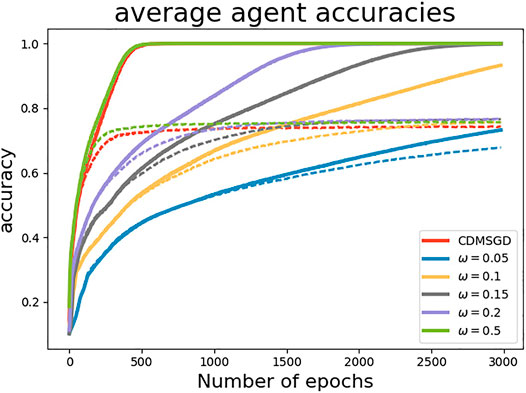
FIGURE 3. Performance of g-CDMSGD for different ω values (Dashed lines represent test accuracy and solid lines represent training accuracy.)
Degree of Consensus. One of the main contribution of our paper is to show that one can control the degree of consensus while maintaining average accuracy in distributed deep learning. We demonstrate this by observing the accuracy difference between the best and the worst performing agents (identified by computing the mean accuracy for the last 100 epochs). As shown in Figure 4, the degree of consensus is similar for all three algorithms for balanced data set, with i-CDMSGD performing slightly better than the rest. However, for an unbalanced set, both i-CDMSGD and g-CDMSGD perform significantly better compared to CDMSGD. Note, the degree of consensus can be further improved for g-CDMSGD using lower values of ω as shown in Figure 5. However, the convergence becomes relatively slower as shown in Figure 3. We do not compare these results with the Federated Averaging algorithm as it performs a brute force consensus at every epoch using centralized parameter server. In Figure 6, we show the performance of i-CDMSGD with different τ values. We observe that while there is better performance by increasing the value of τ, we see that the performance degrades after a while and then quickly stabilizes to similar performance. This is because the doubly stochastic agent interaction matrix for the small agent population becomes stationary very quickly with a very small value of τ. However, this will be explored in our future work with significantly bigger networks.
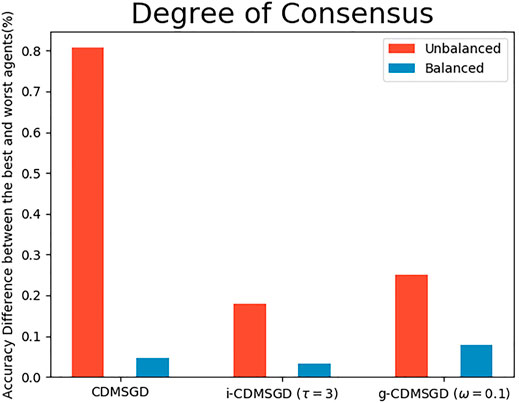
FIGURE 4. The accuracy percentage difference between the best and the worst agents for different algorithms with unbalanced and balanced sample distribution among agents.
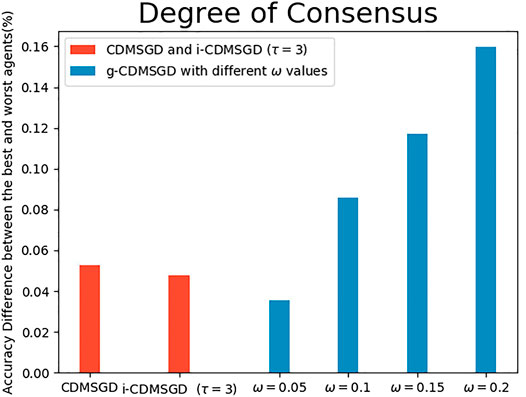
FIGURE 5. The accuracy percentage difference between the best and the worst agents with balanced sample distribution for CDMSGD, i-CDMSGD and g-CDMSGD (varying ω.).
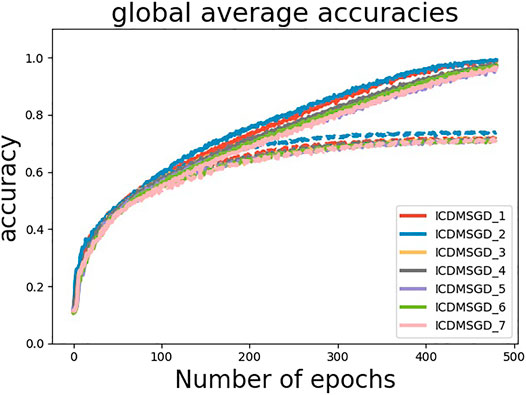
FIGURE 6. Performance of i-CDMSGD for different τ values (Dash lines represent test accuracy and solid lines represent training accuracy).
Finally, we also compare our proposed algorithms to CDMSGD on another benchmark dataset—MNIST. The performance of the algorithms is shown in Figure 7 which follows similar trend as observed for CIFAR-10.
6 Conclusion and Future Work
For investigating the trade-off between consensus and optimality in distributed deep learning with constrained communication topology, this paper presents two new algorithms, called i-CDSGD and g-CDSGD and their momentum variants. We show the convergence properties for the proposed algorithms and the relationships between the hyperparameters and the consensus and optimality bounds. Theoretical and experimental comparison with the state-of-the-art algorithm called CDSGD, shows that i-CDSGD, and g-CDSGD can improve the degree of consensus among the agents while maintaining the average accuracy especially when there is data imbalance among the agents. Future research directions include learning with non-uniform data distributions among agents and time-varying networks.
Data Availability Statement
Publicly available datasets were analyzed in this study. This data can be found here MNIST: http://yann.lecun.com/exdb/mnist/, CIFAR: https://www.cs.toronto.edu/∼kriz/cifar.html.
Author Contributions
ZJ: Writing the whole paper, give the analytical results, and help implement the experiments AB: Help write the paper, mainly implement the experiments and present the numerical results, help finalize the paper CH: Check the writing, analytical and experimental results, and help finalize the paper SS: Check the writing, analytical and experimental results, and help finalize the paper.
Funding
The funder information is: National Science Foundation grant CNS-1954556; National Science Foundation under the CAREER grant CNS-1845969; National Science Foundation under the CAREER grant CCF-1750920/2005804.
Conflict of Interest
The authors declare that the research was conducted in the absence of any commercial or financial relationships that could be construed as a potential conflict of interest.
Publisher’s Note
All claims expressed in this article are solely those of the authors and do not necessarily represent those of their affiliated organizations, or those of the publisher, the editors, and the reviewers. Any product that may be evaluated in this article, or claim that may be made by its manufacturer, is not guaranteed or endorsed by the publisher.
Supplementary Material
The Supplementary Material for this article can be found online at: https://www.frontiersin.org/articles/10.3389/frai.2021.573731/full#supplementary-material
Footnotes
1As our proposed algorithm is a distributed variant of SGD, the noise in the performance is caused by the random sampling Song et al. (2015).
References
Abadi, M., Barham, P., Chen, J., Chen, Z., Davis, A., Dean, J., et al. (2016). “Tensorflow: A System for Large-Scale Machine Learning,” in Proceedings of the 12th USENIX Symposium on Operating Systems Design and Implementation (OSDI-16), Savannah, GA, November 2–4, 2016, 265–283.
Berahas, A. S., Bollapragada, R., Keskar, N. S., and Wei, E. (2018). Balancing communication and computation in distributed optimization. IEEE Transactions on Automatic Control 64(8), 3141–3155.
Blot, M., Picard, D., Cord, M., and Thome, N. (2016). Gossip Training for Deep Learning. Barcelona, Spain: arXiv. preprint arXiv:1611.09726.
Bottou, L., Curtis, F. E., and Nocedal, J. (2018). Optimization Methods for Large-Scale Machine Learning. Siam Review 60(2), 223–311.
Das, D., Avancha, S., Mudigere, D., Vaidynathan, K., Sridharan, S., Kalamkar, D., et al. (2016). Distributed Deep Learning Using Synchronous Stochastic Gradient Descent. arXiv. preprint arXiv:1602.06709.
Dean, J., Corrado, G., Monga, R., Chen, K., Devin, M., Mao, M., et al. (2012). “Large Scale Distributed Deep Networks,” in Advances in neural information processing systems, Lake Tahoe, NV, December 3–8, 2012, 1223–1231.
Duchi, J. C., Agarwal, A., and Wainwright, M. J. (2012). Dual Averaging for Distributed Optimization: Convergence Analysis and Network Scaling. IEEE Trans. Automat. Contr. 57, 592–606. doi:10.1109/tac.2011.2161027
Dvinskikh, D., and Gasnikov, A. (2021). Decentralized and Parallelized Primal and Dual Accelerated Methods for Stochastic Convex Programming Problems. Journal of Inverse and Ill-posed Problems 29 (3), 385–405.
Dvinskikh, D., Gorbunov, E., Gasnikov, A., Dvurechensky, P., and Uribe, C. A. (2019). On Dual Approach for Distributed Stochastic Convex Optimization over Networks. Nice, France: arXiv. preprint arXiv:1903.09844.
Esfandiari, Y., Tan, S. Y., Jiang, Z., Balu, A., Herron, E., Hegde, C., et al. (2021). “Cross-Gradient Aggregation for Decentralized Learning from Non-IID Data,” in Proceedings of the 38th International Conference on Machine Learning, in Proceedings of Machine Learning Research 139, 3036–3046.
Fallah, A., Mokhtari, A., and Ozdaglar, A. (2021). Generalization of Model-Agnostic Meta-Learning Algorithms: Recurring and Unseen Tasks. arXiv. preprint arXiv:2102.03832.
Fallah, A., Mokhtari, A., and Ozdaglar, A. (2020). Personalized federated learning: A meta-learning approach. in Advances in Neural Information Processing Systems. Virtual-only Conference, December 6–12, 2020.
Fang, X., Pang, D., Xi, J., and Le, X. (2019). Distributed Optimization for the Multi-Robot System Using a Neurodynamic Approach. Neurocomputing 367, 103–113. doi:10.1016/j.neucom.2019.08.032
Ge, X., Han, Q.-L., Zhang, X.-M., Ding, L., and Yang, F. (2019). Distributed Event-Triggered Estimation over Sensor Networks: A Survey. IEEE Trans. cybernetics.
Gubbi, J., Buyya, R., Marusic, S., and Palaniswami, M. (2013). Internet of Things (Iot): A Vision, Architectural Elements, and Future Directions. Future Gen. Comput. Syst. 29, 1645–1660. doi:10.1016/j.future.2013.01.010
He, J., Cai, L., Cheng, P., Pan, J., and Shi, L. (2019). Consensus-based Data-Privacy Preserving Data Aggregation. IEEE Trans. Automat. Contr. 64, 5222–5229. doi:10.1109/tac.2019.2910171
He, S., Shin, H.-S., Xu, S., and Tsourdos, A. (2020). Distributed Estimation over a Low-Cost Sensor Network: A Review of State-Of-The-Art. Inf. Fusion 54, 21–43. doi:10.1016/j.inffus.2019.06.026
Hong, M., Lee, J. D., and Razaviyayn, M. (2018). Gradient primal-dual algorithm converges to second-order stationary solution for nonconvex distributed optimization over networks. International Conference on Machine Learning (pp. 2009-2018). PMLR. preprint arXiv:1802.08941.
Hu, R., Guo, Y., Ratazzi, E. P., and Gong, Y. (2020). Differentially Private Federated Learning for Resource-Constrained Internet of Things. arXiv. preprint arXiv:2003.12705.
Jiang, Z., Balu, A., Hegde, C., and Sarkar, S. (2017a). “Collaborative Deep Learning in Fixed Topology Networks,” in Neural Information Processing Systems (NIPS), Long Beach, CA, December 4–9, 2017.
Jiang, Z., Mukherjee, K., and Sarkar, S. (2017b). Generalised Gossip-Based Subgradient Method for Distributed Optimisation. Int. J. Control., 1–17. doi:10.1080/00207179.2017.1387288
Jin, P. H., Yuan, Q., Iandola, F., and Keutzer, K. (2016). How to Scale Distributed Deep Learning? arXiv. preprint arXiv:1611.04581.
Kang, J., Xiong, Z., Niyato, D., Zou, Y., Zhang, Y., and Guizani, M. (2020). Reliable Federated Learning for mobile Networks. IEEE Wireless Commun. 27, 72–80. doi:10.1109/mwc.001.1900119
Lane, N. D., Bhattacharya, S., Georgiev, P., Forlivesi, C., and Kawsar, F. (2015). “An Early Resource Characterization of Deep Learning on Wearables, Smartphones and Internet-Of-Things Devices,” in Proceedings of the 2015 International Workshop on Internet of Things towards Applications (ACM), Seoul, South Korea, November 1, 2015, 7–12. doi:10.1145/2820975.2820980
Lane, N. D., and Georgiev, P. (2015). “Can Deep Learning Revolutionize mobile Sensing?,” in Proceedings of the 16th International Workshop on Mobile Computing Systems and Applications (ACM), Santa Fe, New Mexico, February 12–13, 2015, 117–122.
LeCun, Y., Bengio, Y., and Hinton, G. (2015). Deep Learning. Nature 521, 436–444. doi:10.1038/nature14539
LeCun, Y., Bottou, L., Bengio, Y., and Haffner, P. (1998). Gradient-based Learning Applied to Document Recognition. Proc. IEEE 86, 2278–2324. doi:10.1109/5.726791
Lenz, I., Lee, H., and Saxena, A. (2015). Deep Learning for Detecting Robotic Grasps. Int. J. Robot. Res. 34, 705–724. doi:10.1177/0278364914549607
Lesser, V., Ortiz, C. L., and Tambe, M. (2012). Distributed Sensor Networks: A Multiagent Perspective, 9. Springer Science & Business Media.
Li, M., Andersen, D. G., Smola, A. J., and Yu, K. (2014). “Communication Efficient Distributed Machine Learning with the Parameter Server,” in Advances in Neural Information Processing Systems, Montreal, Canada, December 8–13, 2014, 19–27.
Lian, X., Zhang, C., Zhang, H., Hsieh, C.-J., Zhang, W., and Liu, J. (2017). “Can Decentralized Algorithms Outperform Centralized Algorithms? a Case Study for Decentralized Parallel Stochastic Gradient Descent,” in Advances in Neural Information Processing Systems, Long Beach, CA, December 4–9, 2017, 5336–5346.
McMahan, H. B., Moore, E., Ramage, D., Hampson, S., and Arcas, B. A. y. (2017). Communication-efficient Learning of Deep Networks from Decentralized Data. In Artificial intelligence and statistics, 1273–1282.
Mokhtari, A., and Ribeiro, A. (2016). Dsa: Decentralized Double Stochastic Averaging Gradient Algorithm. J. Machine Learn. Res. 17, 1–35.
Nesterov, Y. (2013). Introductory Lectures on Convex Optimization: A Basic Course, 87. Springer Science & Business Media.
Pu, S., and Nedić, A. (2018). Distributed Stochastic Gradient Tracking Methods. Mathematical Programming 187 (1), 409–457.
Qu, G., and Li, N. (2017). Accelerated distributed Nesterov gradient descent. IEEE Transactions on Automatic Control 65 (6), 2566–2581.
Recht, B., Re, C., Wright, S., and Niu, F. (2011). “Hogwild: A Lock-free Approach to Parallelizing Stochastic Gradient Descent,” in Advances in Neural Information Processing Systems, Granada, Spain, December 12–17, 2011, 693–701.
Scaman, K., Bach, F., Bubeck, S., Lee, Y. T., and Massoulié, L. (2017). “Optimal Algorithms for Smooth and Strongly Convex Distributed Optimization in Networks,” in International Conference on Machine Learning, Sydney, Australia, Auguset 6–11, 2017, 3027–3036.
Song, S., Chaudhuri, K., and Sarwate, A. D. (2015). Learning from Data with Heterogeneous Noise Using Sgd. In Artificial Intelligence and Statistics, 894–902.
Sutskever, I., Martens, J., Dahl, G., and Hinton, G. (2013). “On the Importance of Initialization and Momentum in Deep Learning,” in International conference on machine learning, Atlanta, GA, June 16–21, 2013, 1139–1147.
Tan, F. (2020). The Algorithms of Distributed Learning and Distributed Estimation about Intelligent Wireless Sensor Network. Sensors 20 (5), 1302. doi:10.3390/s20051302
Tsianos, K. I., and Rabbat, M. G. (2012). “Distributed Strongly Convex Optimization,” in Communication, Control, and Computing (Allerton), 2012 50th Annual Allerton Conference on (IEEE), Allerton Park and Retreat Center, IL, October 1–5, 2012, 593–600. doi:10.1109/allerton.2012.6483272
Uribe, C. A., Lee, S., Gasnikov, A., and Nedić, A. (2020). A Dual Approach for Optimal Algorithms in Distributed Optimization over Networks. In 2020 Information Theory and Applications Workshop (ITA). IEEE, 1–37.
Wangni, J., Wang, J., Liu, J., and Zhang, T. (2017). Gradient Sparsification for Communication-Efficient Distributed Optimization. Montreal, Canada: arXiv. preprint arXiv:1710.09854.
Wen, W., Xu, C., Yan, F., Wu, C., Wang, Y., Chen, Y., et al. (2017). “Terngrad: Ternary Gradients to Reduce Communication in Distributed Deep Learning,” in Advances in Neural Information Processing Systems, Long Beach, CA, December 4–9, 2017, 1508–1518.
Xu, Z., Taylor, G., Li, H., Figueiredo, M., Yuan, X., and Goldstein, T. (2017). “Adaptive Consensus Admm for Distributed Optimization,” in International Conference on Machine Learning, Sydney, Australia, August 6–11, 2017, 3841–3850.
Yang, S., Tahir, Y., Chen, P.-y., Marshall, A., and McCann, J. (2016). “Distributed Optimization in Energy Harvesting Sensor Networks with Dynamic In-Network Data Processing,” in IEEE INFOCOM 2016-The 35th Annual IEEE International Conference on Computer Communications (IEEE), San Francisco, CA, April 10–15, 2016, 1–9. doi:10.1109/infocom.2016.7524475
Zhang, S., Choromanska, A. E., and LeCun, Y. (2015). “Deep Learning with Elastic Averaging Sgd,” in Advances in Neural Information Processing Systems, Montreal, Canada, December 7–12, 2015, 685–693.
Zhang, W., Zhao, P., Zhu, W., Hoi, S. C., and Zhang, T. (2017). “Projection-free Distributed Online Learning in Networks,” in International Conference on Machine Learning, Sydney, Australia, August 6–11, 2017, 4054–4062.
Keywords: distributed optimization, consensus-optimality, collaborative deep learning, sgd, convergence
Citation: Jiang Z, Balu A, Hegde C and Sarkar S (2021) On Consensus-Optimality Trade-offs in Collaborative Deep Learning. Front. Artif. Intell. 4:573731. doi: 10.3389/frai.2021.573731
Received: 18 June 2020; Accepted: 19 August 2021;
Published: 14 September 2021.
Edited by:
Fabrizio Riguzzi, University of Ferrara, ItalyReviewed by:
Arnaud Fadja Nguembang, University of Ferrara, ItalyClaudio Gallicchio, University of Pisa, Italy
Copyright © 2021 Jiang, Balu, Hegde and Sarkar. This is an open-access article distributed under the terms of the Creative Commons Attribution License (CC BY). The use, distribution or reproduction in other forums is permitted, provided the original author(s) and the copyright owner(s) are credited and that the original publication in this journal is cited, in accordance with accepted academic practice. No use, distribution or reproduction is permitted which does not comply with these terms.
*Correspondence: Zhanhong Jiang, c3RhcmtqaWFuZ0BnbWFpbC5jb20=
 Zhanhong Jiang
Zhanhong Jiang Aditya Balu
Aditya Balu Chinmay Hegde
Chinmay Hegde Soumik Sarkar
Soumik Sarkar